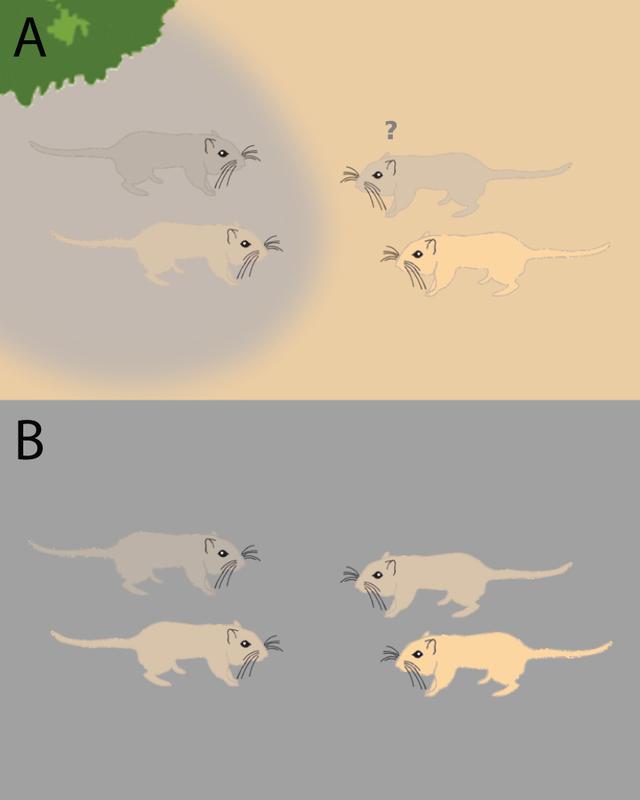How gerbils orient in the light of the setting sun

A dark-colored gerbil (figure A, top right) recognizes its dark fellow, although due to the shadow the fur of the light brown animal (bottom left) has a more similar spectral composition (figure B). Copyright: Association for Research in Vision and Ophthalmology, 2015
A green apple is green, but the green is not always the same. In varying light conditions—like at sunset—the spectrum of the light that is reflected by the fruit and falls on our retina, changes. Nevertheless, we continue to perceive the color of the apple as green because the human brain compensates for the influences of illumination by evaluating the color and brightness composition across the entire visual field.
This capacity is known as color and brightness constancy and is important for object recognition. Researchers at the Bernstein Center Munich and the LMU Munich, led by Kay Thurley and Thomas Wachter, have now investigated whether rodents also possess this remarkable perceptual ability.
In the study, the researchers showed gerbils colored patches on different colored backgrounds. The animals were looking at a screen while sitting on a sphere that worked like a treadmill. They were thus able to virtually move towards the stimuli and select one of it as response.
During the experiment, half of the animals had to identify the object in which the patch appeared more greenish than its background. The other animals had to identify the object they perceived as bluish compared to its background. When the rodents gave the correct answer, they received a food reward.
“The gerbils reliably recognized the correct patches despite varying color compositions across the experimental trials,” explains Thomas Wachtler. Hence, under different lighting conditions the rodents consistently perceive a green apple or a brown fur as green or brown, respectively.
Moreover, they also perceive the brightness of an object as constant, as the researchers demonstrated in another experiment. Gerbils are thus the first rodents shown to have the ability of color and brightness constancy. The result suggests that other animals may possess this perceptual ability, too.
“For gerbils, which are diurnal and crepuscular animals, the ability to accurately identify objects despite changing lightning conditions is essential for survival. They orient using their sense of vision to forage or recognize conspecifics,” says Kay Thurley, main author of the study. The result has significant implications for neurobiology: “Gerbils are a popular animal model in auditory neuroscience. But in contrast to other rodents, gerbils also have well developed vision, making these rodents especially suitable for experiments in virtual realities,” Thurley says.
The Bernstein Center Munich is part of the National Bernstein Network Computational Neuroscience in Germany. With this funding initiative, the German Federal Ministry of Education and Research (BMBF) has supported the new discipline of Computational Neuroscience since 2004 with over 180 million Euros. The network is named after the German physiologist Julius Bernstein (1835-1917).
Contact:
PD Dr. Thomas Wachtler
LMU Munich
Department Biology II
Großhaderner Straße 2
82152 Martinsried
Tel: +49 (0)89 2180 74810
Email: wachtler@bio.lmu.de
Dr. Kay Thurley
LMU Munich
Department Biology II
Großhaderner Straße 2
82152 Planegg-Martinsried
Tel: +49 (0)89 2180 74823
E-Mail: thurley@bio.lmu.de
Original publication:
C. Garbers, J. Henke, C. Leibold, T. Wachtler & K. Thurley (2015): Contextual processing of brightness and color in Mongolian gerbils. Journal of Vision, 15(1), 1 – 13.
doi: 10.1167/15.1.13
http://www.bccn-munich.de/people/kay-thurley Webpage Kay Thurley
http://neuro.bio.lmu.de/research_groups/res-wachtler_th Webpage Thomas Wachtler
http://www.uni-muenchen.de LMU Munich
http://www.bccn-munich.de Bernstein Center Munich
http://www.nncn.de/en National Bernstein Network Computational Neuroscience
Media Contact
All latest news from the category: Life Sciences and Chemistry
Articles and reports from the Life Sciences and chemistry area deal with applied and basic research into modern biology, chemistry and human medicine.
Valuable information can be found on a range of life sciences fields including bacteriology, biochemistry, bionics, bioinformatics, biophysics, biotechnology, genetics, geobotany, human biology, marine biology, microbiology, molecular biology, cellular biology, zoology, bioinorganic chemistry, microchemistry and environmental chemistry.
Newest articles

A ‘language’ for ML models to predict nanopore properties
A large number of 2D materials like graphene can have nanopores – small holes formed by missing atoms through which foreign substances can pass. The properties of these nanopores dictate many…

Clinically validated, wearable ultrasound patch
… for continuous blood pressure monitoring. A team of researchers at the University of California San Diego has developed a new and improved wearable ultrasound patch for continuous and noninvasive…

A new puzzle piece for string theory research
Dr. Ksenia Fedosova from the Cluster of Excellence Mathematics Münster, along with an international research team, has proven a conjecture in string theory that physicists had proposed regarding certain equations….



